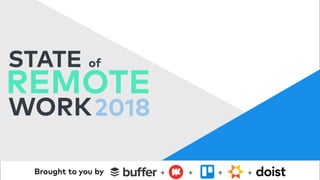
State of Remote Work 2018 [Data & Analysis]
- 2. Overview To better understand how remote work is changing we teamed up with Workfrom and Hubstaff and collected data from over 1,900 remote workers around the world to create the State of Remote Work 2018 report. The report shows us how remote workers around the world are working, the benefits and struggles of working remotely, and what changes they’re making for the future. Here’s what this report will cover…
- 3. Contents 1. How Satisfied Are Remote Workers 2. The Benefits and Struggles of Working Remotely 3. Where Do Remote Workers Actually Work? 4. How Companies Are Thinking About Remote Work in 2018 5. How Much Remote Workers Earn
- 4. Who we surveyed We had 1,900 remote workers from 90 countries around the world participate in the survey that helped create this report. Most of the people we surveyed work in the software industry (26%) followed by IT and Services (20%) and Marketing (19%). Respondents primarily work on marketing (25%) and engineering (22%) teams. The majority of respondents (58%) work remotely for a company while 28% work as freelancers and 14% run their own companies.
- 5. 1. How Satisfied Are Remote Workers
- 6. A large majority of respondents, 90%, would prefer to work remotely for the rest of their careers. Do remote workers want to be remote for the rest of their careers?
- 7. A large majority of respondents, 94%, encourage others to work remotely. Do remote workers encourage others to work remotely?
- 8. 2. The Benefits and Struggles of Working Remotely
- 9. The biggest benefit to working remotely is the ability to have a flexible schedule — 43% of remote workers were in agreement about this. The second biggest benefit? Being able to spend time with family (15%). What’s the biggest benefit to working remotely?
- 10. Loneliness (21 percent), collaborating and/or communicating (21 percent) and distractions at home (16 percent) are the biggest struggles of remote workers. What’s the biggest struggle to working remotely?
- 11. According to our data, 55% of remote workers take fewer than 15 days of vacation per year. The smallest range of vacation days in our survey — 0 to 5 days — is the norm for 16% of remote workers. How many vacation days do remote workers take?
- 12. 3. Where Do Remote Workers Actually Work?
- 13. For 78% of remote workers, home is their primary place of work. The office came in as the runner-up work location with 9% of the respondents, and coworking spaces came in at 7%. Where do remote workers primarily work from?
- 14. A majority of respondents, 81%, have traveled outside of their home city and worked at the same time. Do remote workers ever travel outside of their home city and work at the same time?
- 15. A total of 43% of respondents said they spend 10% or less of their time traveling while working remotely. What percentage of the year do remote workers who travel, travel and work at the same time?
- 16. 4. How Companies Are Thinking About Remote Work in 2018
- 17. A majority of respondents, 70%, work 100% remotely. How many remote workers are remote 100% of the time?
- 18. For workers who aren’t 100% remote, the majority (32%) work remotely between 11-30% of their time. What percentage of time do remote workers work remotely?
- 19. Of the companies with remote workers, 22 percent have fewer than 10 employees, 17 percent have 11-25 employees, and 15 percent have over 1,000 employees. What percentage of employees work remotely?
- 20. 5. How Much Remote Workers Earn
- 21. The results show that 28 percent of remote workers make less than $25,000 USD per year,18 percent make $25,001 - $50,000, and18 percent make $50,001 - $75,000. How much to remote workers make per year?
